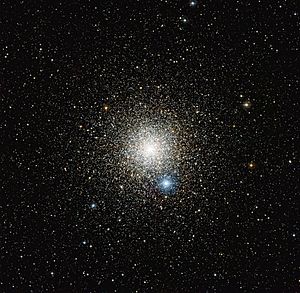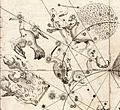Pavo (constellation) facts for kids
| Constellation | |

List of stars in Pavo
|
|
| Abbreviation | Pav |
|---|---|
| Genitive | Pavonis |
| Pronunciation | genitive |
| Symbolism | the Peacock |
| Right ascension | 18h 10.4m to 21h 32.4m |
| Declination | −56.59° to −74.98° |
| Quadrant | SQ4 |
| Area | 378 sq. deg. (44th) |
| Main stars | 7 |
| Bayer/Flamsteed stars |
24 |
| Stars with planets | 6 |
| Stars brighter than 3.00m | 1 |
| Stars within 10.00 pc (32.62 ly) | 4 |
| Brightest star | α Pav (Peacock) (1.91m) |
| Messier objects | 0 |
| Meteor showers | Delta Pavonids August Pavonids |
| Bordering constellations |
Octans Apus Ara Telescopium Indus |
| Visible at latitudes between +30° and −90°. Best visible at 21:00 (9 p.m.) during the month of August. |
|
Pavo is a beautiful constellation located in the southern part of the night sky. Its name means "peacock" in Latin. This constellation is one of the "Southern Birds" group. It was first mapped by Dutch explorers in the late 1500s.
Pavo is best seen from the Southern Hemisphere. It can be spotted during the month of August. It is a medium-sized constellation. Pavo ranks as the 44th largest constellation in the sky.
Contents
Discovering Pavo
Who Named Pavo?
Pavo was first described by Dutch navigators Pieter Dirkszoon Keyser and Frederick de Houtman. They explored the southern seas between 1595 and 1597. They mapped many new stars and constellations. These were not visible from Europe.
The constellation was later included in a famous star atlas. This atlas was called Uranometria. It was published by Johann Bayer in 1603. This is how Pavo became widely known.
Where Can You See Pavo?
Pavo is a southern constellation. This means it is visible from the Southern Hemisphere. People living south of 30 degrees North latitude can see it. It is always above the horizon for observers in the far south. This includes places like Australia and South Africa.
Stars of Pavo
The Brightest Star: Peacock
The brightest star in Pavo is called Alpha Pavonis. It is also known as Peacock. This star shines with a blue-white light. It is about 179 light-years away from Earth. Peacock is a very hot and luminous star. It is much brighter than our Sun.
Other Notable Stars
Pavo has other interesting stars too. Delta Pavonis is a star similar to our Sun. It is only about 19.9 light-years away. Scientists study stars like Delta Pavonis. They look for planets that might orbit them.
Kappa Pavonis is a special type of star. It is a Cepheid variable. This means its brightness changes over time. It gets brighter and dimmer in a regular pattern. These stars help astronomers measure distances in space.
Deep-Sky Objects in Pavo
Globular Cluster NGC 6752
Pavo is home to a stunning globular cluster called NGC 6752. This cluster is a dense ball of very old stars. It contains an estimated 100,000 stars. These stars are packed tightly together. NGC 6752 is one of the brightest globular clusters in the sky. It can even be seen with binoculars from dark locations.
Spiral Galaxy NGC 6744
Another amazing object in Pavo is the spiral galaxy NGC 6744. This galaxy looks a lot like our own Milky Way Galaxy. It has a bright central bulge and spiral arms. NGC 6744 is about 30 million light-years away. It is a great example of a large spiral galaxy.
Meteor Showers
Pavo is also associated with two meteor showers. These are the Delta Pavonids and the August Pavonids. Meteor showers happen when Earth passes through dust trails left by comets. The dust particles burn up in our atmosphere. This creates streaks of light we call "shooting stars."
Images for kids
-
Pavo (upper right), with the other southern birds, in its first appearance in a celestial atlas, Johann Bayer's Uranometria.
-
The constellations Pavo and Indus, featured in the chart of the Southern Celestial Hemisphere by Johann Gabriel Doppelmayr in his Atlas Coelestis, c. 1742
See also
 In Spanish: Pavo (constelación) para niños
In Spanish: Pavo (constelación) para niños




